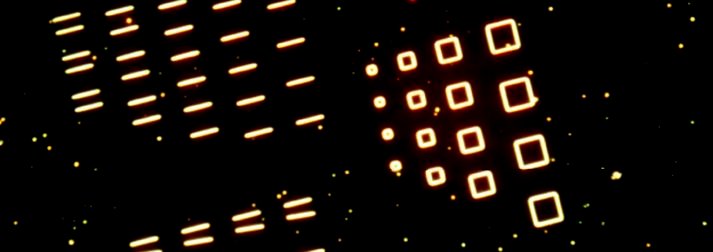Plasmonics & Nanophotonics

Plasmonics is the modern field of physics aimed at the interaction between electromagnetic field and free electrons in a metal on metal-dielectric interfaces or in metallic nanoparticles with dielectric surrounding. Our group is oriented mainly on the fabrication of metal nanostructures and structured metal-dielectric interfaces by various methods such as electron beam lithography, focused ion beam, ion beam assisted deposition, selective deposition of metal nanoparticles etc. Moreover, we are able to measure optical properties of the fabricated structures by means of optical dark-field spectroscopy, spectroscopic ellipsometry, scanning near field optical microscopy techniques and fourier transform infrared spectroscopy. The main goal is to utilize the fabricated and characterized plasmonic structures in applications, i.e. plasmon-enhanced photoluminescence, plasmon-enhanced infrared absorption, surface enhanced infrared spectroscopy, enhanced biosensing and optical manipulation below the diffraction limit.
For further details, contact Tomáš Šikola (sikola(at)fme.vutbr.cz).
Laboratory of Near Field Optics
Excitation and detection of surface plasmon polaritons propagating along the metal-dielectric interface; detection of scattered electromagnetic field from metallic nanostructures; biosensors; read more...
Laboratory of Photoluminescence
Design and fabrication of quantum dots; detection and interpretation of photoluminescence signal; read more...
Theoretical & Computational Physics
Simulation and modeling of the interaction of electromagnetic field with nanostructures; interpretation of experimental data; read more...
Recent publications of the group
- Tesi, Bloos, Hrtoň et al. Small Met. (2021), 2100376
- Kepič et al. ACS Phot. 8 (2021), 1048
- Kejík et al. Opt. Express 28 (2020), 34960
- Horák et al. Ultramiscroscopy 216 (2020), 113044
- Hrtoň et al. Phys. Rev. Appl. 13 (2020), 054045
- Liška et al. Microel. Eng. 228 (2020), 111326
- Křápek et al. Nanophot. 9 (2020), 623
- Ligmajer et al. J. Phys. Chem. 123 (2019), 16957
- Horák et al. Sci. Rep. 9 (2019), 4004
- Bouchal, Dvořák et al. Nano Lett. 19 (2019), 1242
- Dvořák et al. Nanoscale 10 (2018), 21363
- Břínek, Kvapil et al. ACS Phot. 10 (2018), 4378
- Ligmajer et al. ACS Phot. 5 (2018), 2561
- Horák et al. Sci. Rep. 8 (2018), 9640
- Faβbender, Babocký, et al. APL Photonics 3 (2018), 110803
- Hrtoň et al. Opt. Express 25 (2017), 23709
- Dvořák et al. Opt. Express 25 (2017), 16560
- Babocký et al. ACS Photonics 4 (2017), 1389
- Kvapil et al. Phys. Stat. Sol. A 1-8 (2016), DOI10.1002/pssa.20153292
- Babocký et al. J. Vac. Sci. & Tech. B 34 (2016), 06K801
- Křápek et al. Opt. Express 23 (2015), 11855
- Zallo, Trotta, Křápek, et al. Phys. Rev. B 89 (2014), 241303(R)
- Huo, Křápek, et al. Phys. Rev. B 90 (2014), 041304(R)
- Dvořák et al. Nano Lett. 13 (2013), 2558
- Kalousek et al. Opt. Express 20 (2012), 17916
- Dub et al. Acta Cryst. A 68 (2012), 494
- Šikola et al. Appl. Phys. Lett. 95 (2009), 253109
Collaboration with other groups
Colloidal nanoparticles represent an ideal building blocks for plasmonic devices, since their dimensions and shape can be precisely controlled during the fabrication step. However, assembly of these particles directly from the solution seems to be an issue. We investigate mechanisms of nanoparticle adsorption from colloidal solutions on solid substrates and develop techniques for selective adsorption of single nanoparticles.

Fig.:Negative deposition: colloidal 20-nm-gold nanoparticles do not adhere to the areas which were previously irradiated by 5 keV Ga+ ion beam. See the related publication: Kolíbal et. al., ACS Nano 6 (2012) 10098.
For further details, contact Miroslav Kolíbal (kolibal.m(at)fme.vutbr.cz).
